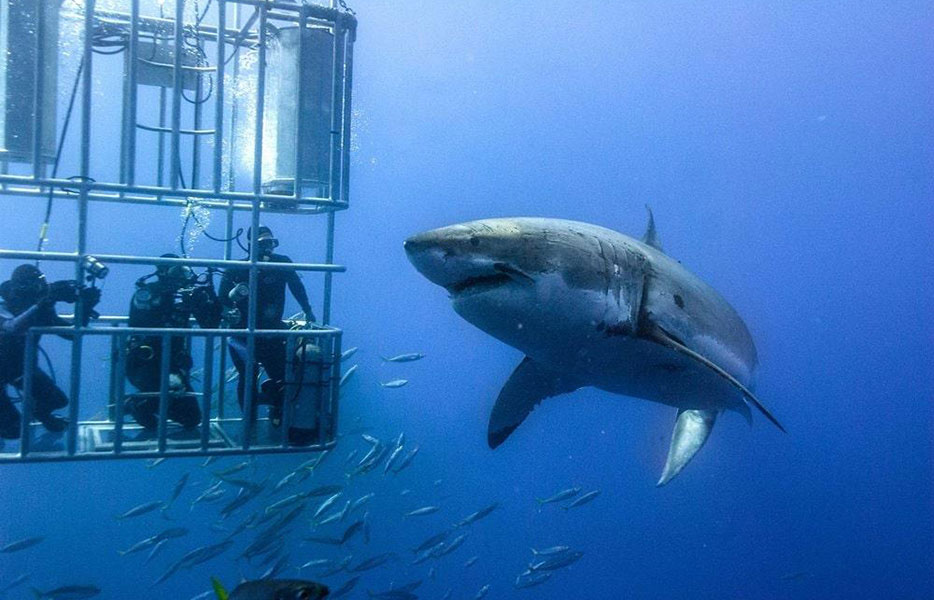SeaQuest’s Guide to Sharks!
Share it on:

Sharks are magnificent creatures and the most famous of predators in the sea! It’s easy to see why so many people are captivated by them. And though we still have much to learn about the wide variety of shark species in the oceans, one of the most important opportunities we’ve had to gain more knowledge about sharks in recent years is Shark Week! Each year, Shark Week celebrates these amazing and unique animals. The week also brings awareness about some of the threats that sharks face every day. In honor of the celebration, here’s a brief guide to sharks and fun facts to take away before you venture on your next animal learning adventure.
What is Shark Week?
Believe it or not, Shark Week originates all the way back to 1987. Named for a special television special event, Discovery Channel developed a concept to create a weeklong extravaganza of shows and programs all about sharks. Since then Shark Week has evolved into a pop culture juggernaut. It’s now the longest-running cable TV programming event ever, and it continues to grow in ratings and popularity year over year. The first-ever Shark Week debuted in the summer of 1988 with the show Caged in Fear. The show explored the science of creating and testing motorized shark cages. On top of that, Shark Week benefited immensely from its implicit association with Steven Spielberg’s mega-blockbuster Jaws, which was released in 1975. Shark Week inspires people to learn about conservation of sharks and marine life. It’s an in-depth and scientific look at the lives of sharks, without trying to glorify them. The most important thing to remember is that they are fierce predators and the vast majority of sharks want to be left alone by humans.
Did You Know? The species featured in the movie, Jaws, is the Great White. However, there are no Great White Sharks held in captivity anywhere on the planet! Several attempts have been made to house the animal safely in oceanic facilities throughout the world but the longest one has only survived in captivity for 198 days.
How Many Species of Sharks Exist?
Sharks have existed for more than 400 million years! Today, there are more than 500 species of sharks throughout the world’s oceans. Sharks and their relatives were the first vertebrate predators in evolution and over millions of years their effectiveness at survival has allowed them to stay at the top of hunters and predators in the animal kingdom. When most people think of these fish, they usually picture the large, sharp-toothed, scary beast from movies and pictures. But that image does sharks a huge disservice. They have far more variety than that. Most sharks range in size from 1 foot to more than 39 feet long. Half of all shark species are less than 3 feet long. They can be found in just about every kind of ocean habitat on earth: The deep sea, open ocean, coral reefs, swamplands and river waterways and even under the Arctic ice.
World’s Largest Shark: The Whale shark is the largest species of shark. They grow to about 40 feet.
World’s Smallest Shark: At only 6 inches, the Dwarf Lantern is one of the smallest species of shark and it can fit in the palm of your hand.
Oldest Shark Species: Cladoselache is regarded as the first “true shark”. It lived 380 million years ago.
Youngest Shark Species: The youngest living group of sharks are thought to be the distinctive hammerhead sharks.
What Do Sharks Eat?
Interestingly enough, sharks only eat about 2% of their total body weight. They mostly snack on other small fish, plankton, squid or small marine mammals. Overall, sharks eat what is available to them. Crab, clams, lobster or even other smaller sharks. The Great White is by far the head of the food chain. However, killer whales have been known to attack and feed on Great Whites, if they can catch them. Sharks can go days, weeks or even months without eating. Because they are cold blooded, they don’t burn energy as fast. This requires fewer meals for them. They also can survive on the oil that is stored in their liver. When liver oils get low, this signals them to find their next meal. Fish provide the best source of lean protein, oils and omega-3 fatty acids.
Something we can learn from sharks is to observe their eating habits and learn how to not overeat. Although they may not know exactly where their next meal will come from, sharks only eat what they need to eat when they need to eat it.
Do All Sharks Have Teeth?
Yes… and no! While mostly all shark species have some form of “teeth” some sharks do not fit in the toothed category. There are a few species of toothless sharks who do not possess star-like sharp teeth that we are all familiar with. Instead, they have tiny teeth and filter pads called gill rakers which they use to filter large amounts of tiny plankton to eat daily. Those that feed on tiny planktons swim with their mouth open to gulp in as much food as possible. These sharks need to filter large gallons of water to take in food. Whale sharks and Basking sharks are two that are categorized as sharks with no teeth. In addition, toothless sharks have wider mouths that can stretch up to 4 feet wide to gulp in gallons of water per swim.
Fun Shark Facts
- Shark Teeth Style: For centuries, many cultures have used shark teeth for weapons including knives and other cutting tools, as well as a fashion accessory for jewelry. Shark teeth are often found on necklaces tied with leather bound cords and worn by natives on many island nations.
- Smooth as Sharks: Sharks are smooth and streamlined swimmers.Their body types have inspired inventors to make boats, submarines, and even airplanes more aerodynamic, mimicking the body of a shark.
- No Barneys Here: Barnacles and algae don’t grow on shark skin.
- Sharks Illness: Sharks rarely get sick. They have super high efficient immune systems! Scientists study sharks to find ways to help prevent and cure diseases. A chemical called squalamine can be found in Spiny Dogfish sharks and it kills bacterial microbes that also remove potential tumor cells.
- Out for Blood: Sharks also have a special anticlotting compound found in their blood which has helped researchers to seek out ways to prevent heart disease in humans.
- Sharks Never Sleep? Sharks swim while they sleep! Researchers theorize something in the brain of sharks could lead to the treatment of sleep disorders in humans.
- Shark The Boneless: Sharks do not have bones. They are known as “elasmobranchs”, which translates into fish made of cartilaginous tissues. The cartilaginous skeletons have much lighter bone and their large livers are full of low-density oils which helps them to be buoyant.
Why are Sharks Important?
Sharks help to balance coral ecosystems. They feed off certain invasive species, prevent the spread of diseases carried by ailing fish, and encourage marine diversity. They are a keystone of the food chain and keep the carbon cycle in motion. Simply put, they help to combat climate change. Sharks are apex predators and play a vital role in maintaining most marine ecosystems. Without them, marine animals and habitats would suffer. But sharks do face some serious threats, the biggest one being shark finning. The practice of shark finning can significantly affect humans in that shark products can contain dangerous levels of mercury, presenting a public health risk.
Shark Finning Facts
- 100 million sharks are killed annually.
- It’s estimated that over 72 million sharks are killed annually just for shark fin soup.
- In the United States, only 11 states have bans against the sale of fins.
- The Blue shark is one of the most commonly traded species, with around 20 million killed for their fins every year.
- According to the International Union for Conservation of Nature (IUCN), there are nearly 100 species of sharks at high risk of global extinction.
- Shark fin soup is sold at many restaurants around the world, with a single bowl going for up to $100 a bowl.
Are Sharks Endangered?
Most shark species have sustainable populations however some of them are diminishing at an alarming rate. As explained above, shark finning is a large cause for this. Other reasons include overfishing and rising ocean temperatures which increase the risk of irreversible loss of marine and coastal ecosystems. Because of initiatives such as Shark Week, there is a stronger awareness about vulnerable shark species. Many countries have implemented shark fin bans. Regions and nations around the world are working together to promote the adoption of shark conservation and management measures. This means increased protection for particular sharks and focus on creating a healthy ocean. Endangered sharks and all endangered animals still need our help.
Sharks that Live at SeaQuest
A visit to SeaQuest today can be a great way to celebrate Shark Week this year! Through your SeaQuest journey, here are a few species of the sharks that you’ll get to meet up close and personal and learn even more about shark habitats and conservation!
- Blacktip Reeftip: Blacktip Reef Sharks can be easily identified by the black tips on all of their fins. They are one of the most commonly seen species of shark found in the Pacific Ocean’s tropical coral reefs. Unfortunately, these beautiful sharks are prone to overfishing, and with their low reproductive rate, their population can struggle to rebound. Luckily, Blacktip Reef Sharks are thriving in captivity.
- Whitespotted Bamboo: Reaching lengths of up to 37 inches long, the Whitespotted Bamboo Shark can be spotted in coral reefs of the Pacific Ocean. While they are most commonly found in the coastal areas of Indonesia, they are also known to inhabit waters from Japan to India. They love to eat bony fish and crustaceans, with some of their favorite snacks being clams, scallops, and shrimp!
- Horn Sharks: Easily recognized by their short, broad head, blunt snout and prominent ridges above their eyes. While young, horn sharks can be found in long, sandy areas, but as adults, they often move to intricate rocky reefs or algae beds. Horn sharks can be found at depths of anywhere between 6 to 660 feet! Horn Sharks are definitely homebodies, the longest recorded distance a Horn Shark has ever traveled is 10 miles!
- Nurse Shark: The origin of this name is unclear, but the belief is the sucking sound nurse sharks make when hunting prey in the sand resembles a nursing baby’s sound. Nurse sharks are slow swimmers and bottom-dwelling sharks. Their strong mouths are filled with thousands of tiny teeth that dine on invertebrates and fish. Nurse sharks are smooth to the touch and are a brown-grey color; the large tail fins that adorn their bodies can be up to one-fourth their total length!
- Smooth Greyhound Shark: Grey Smoothhound Sharks are relatively small, averaging 3-4 feet in length. In order to avoid larger sharks, they spend most of their time swimming on the ocean floor. Female Grey Smoothhound Sharks give live birth and these sharks have a lifespan of approximately 6 – 9 years.
SeaQuest is committed to protecting our world’s oceans and endangered animals. We focus on how to be proactive in finding solutions. To learn more about how you can help SeaQuest with this cause, book your visit today at any of the following locations: Utah, Las Vegas, Dallas-Fort Worth, Denver, Sacramento, Minneapolis, Connecticut, Lynchburg, New Jersey, and Atlanta.




